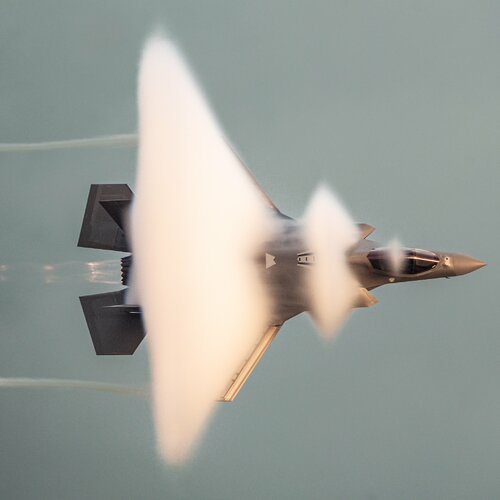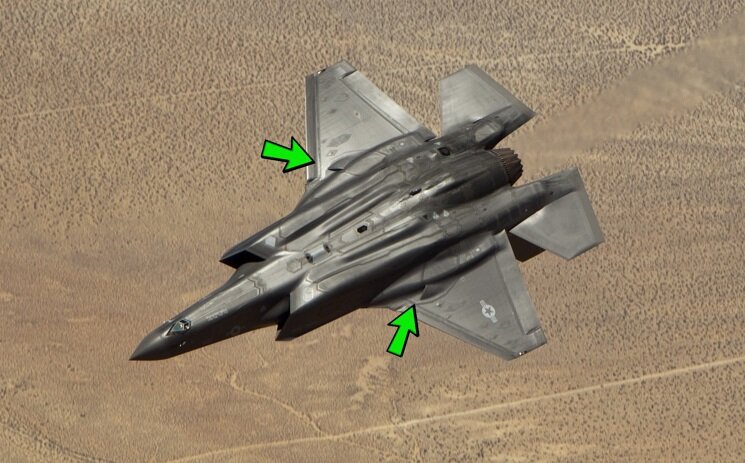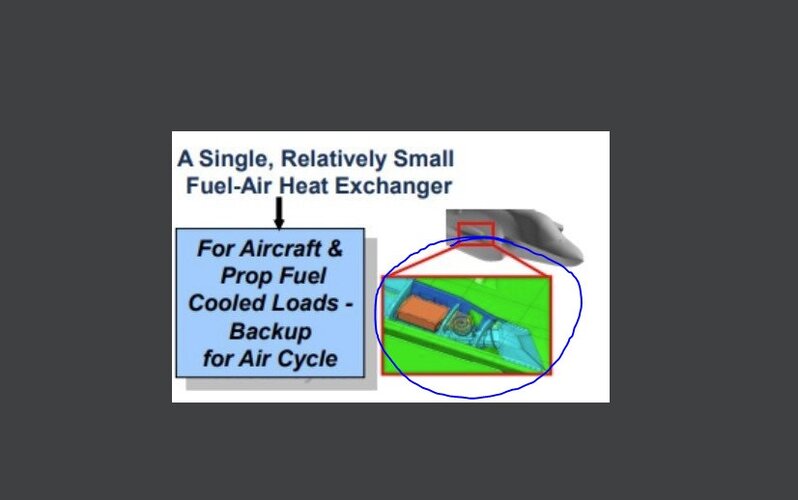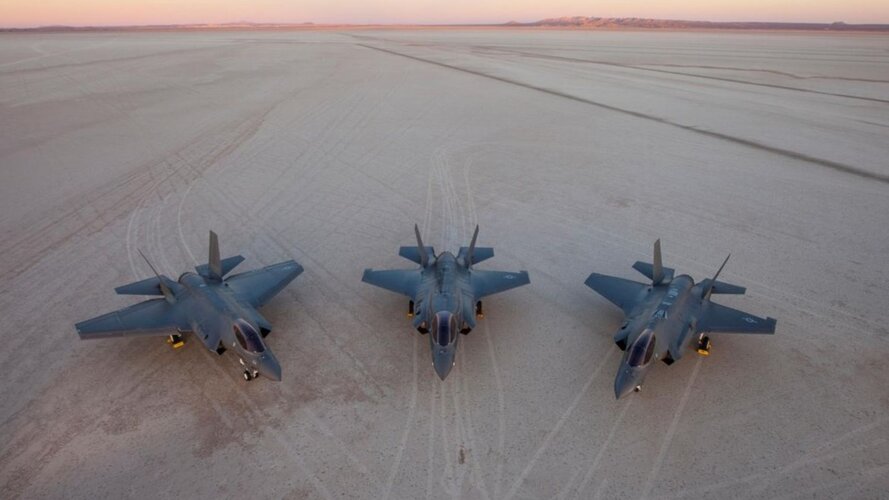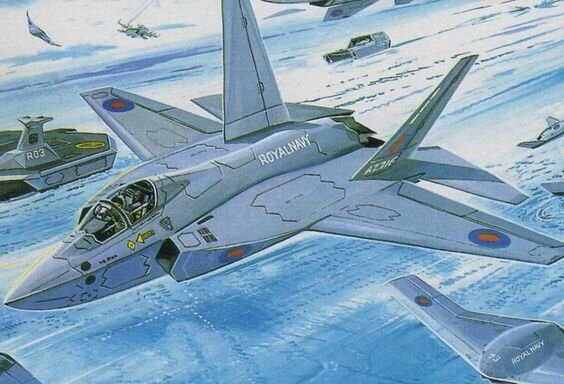You are using an out of date browser. It may not display this or other websites correctly.
You should upgrade or use an alternative browser.
You should upgrade or use an alternative browser.
Lockheed Martin F-35 Lightning II Joint Strike Fighter (JSF)
- Thread starter Triton
- Start date
I think going with F-35 ECU is good from the cost stand point but I think it is terrible from the performance stand pointKendall: F135 Upgrade The Only Option For All F-35 Variants | Aviation Week Network
Air Force Secretary Frank Kendall has decided not to proceed with replacing the F-35’s F135 powerplant with either of two alternatives.aviationweek.com
Wholehearteadly agree with him on this! I know i'll probably get some flak, but in a way i'm happy that cool heads prevailed and decided not to go with the uber-expensive AETP reengine route. With the current budget realities, it was a matter of time before being forced to choose which aircaft do you want new engines to go in: F-35, or NGAD. And siding with the F-35 would have meant no NGAP. Aka: A repeat of the YF-119 vs YF-120 saga, except this time propitiated by lack of cash.
For starters, besides the integration troubles with the B and C variants, is it worth the hassle when it's combat range isn't that great to begin with ?(for the Pacific) Yes, the XA-100 would have provided a 30% increase, but how much is that?
Hastily made comparison of what a 30% increase would look like without taking other factors into account.
669nmi, 6.69*30+669=869nmi 505nmi, 5.05*30+505=656.5nmi 670nmi: 6.7*30+670=871nmi
I mean it's good, but not that much of an improvement, measly 200nmi, with only 150 for the B. The MQ-25, set to enter service in 2026, and adding couple of LO EFT's under each wing could extend it to 1400-1700nmi and i feel still wouldn't be enough for the distances of the Pacific and/or to safely operate outside the Chinese A2/AD bubble. For an engine upgrade to be effective, an obligatory combat radius of at least 1000nmi on internal fuel would be ideal.
Now let's see how a mix of historical, current and proposed planes would fare with ACEs , again a very simplistic calculation, without payload, altitude, speed or weight considered.
Combat radius: 1100nmi 11.0*38+1100=1518nmi
Combat radius: 1740nmi
Combat radius: 1830nmi
Combat radius: 1800nmi
30% vs 38% increase in radius! That's insane! NGAD is supposed to be BIG, so how far it could go, compared to all F-35 versions, would increase exponentially the more fuel the plane carries. It is obvious the bearing costs of a retrofit wouldn't have been worthy, and a larger plane with deeper fuel tanks capable of crossing vast distances from the start will see itself more beneffited than a small airframe.
(Meanwhile, in an AU, those in charge are pulling their hairs after the NGAP effort stalls in favor of developing a conventional turbofan engine, resulting in a 6th gen with Ok-ish reach and watered down capabilities, since the funds that otherwise would've been allocated to its development were eaten giving F-35s new shiny engines! Buy hey, that's what mattered, right?)
(Everything written above is entirely subjective and just my 2 Cents opinion)
1- How many NGAD will they make ? consider that it is much bigger than F-22, I think it will be extremely expensive and surely can't have the same quantity as F-35
2- As the back bone fighter of USAF and USN, F-35 kinematic is really bad compared to other 5 gen aircraft. F-35 has terrible T/W compared to Su-57 and J-20.
At 50% fuel and 6 AAM
F-35A with F-135 => T/W = 1.05
F-35A with F-135ECU => T/W = 1.17
Su-57 with AL-41F1 => T/W = 1.24
Su-57 with izdeliye 30 => T/W = 1.45
J-20 with WS-10B => T/W = 1.11
J-20 with WS-15 => T/W = 1.54
Even worse if we recall that J-20 and Su-57 can fly further on 50% fuel
Somewhat off topic but I will say this in response. While JIT has issues in many cases this is because the supply chains in those cases were not fully implemented to allow for. If done correctly, and in industries where it is practical, it is a efficient approach.
"Just in time" is the worst idiocy ever happened to logistics in the last half-century. Toyota, how we hate you.
It has been edited more subtle, but it is a different photo.That thing has been photoshopped within an inch of its life. Here's the original:
La-Fuente Technologies
F-47 NEXT GENERATION AIR DOMINANCE
- Joined
- 21 November 2022
- Messages
- 370
- Reaction score
- 355

Rep. Wittman on F-35 engine upgrade, KC-46 concerns and which USAF plane's 'time is done' - Breaking Defense
"I can tell you, this is going to get re-litigated in the committee and on the floor. And I just want to make sure people have the full scope of information to make the decision," said Wittman on the F-35's next engine.
WASHINGTON — For years, Rep. Rob Wittman, R-Va,. was known as a leading voice on naval matters in Congress. But with the 118th Congress, Wittman has left his ship committee behind and taken on the role of chairman on the House Armed Services Committee’s tactical air and land forces subcommittee.
Following a subcommittee hearing on March 29, Breaking Defense sat down with Wittman to discuss his key priorities for the Air Force.
The transcript has been edited for length and clarity.
Breaking Defense: At the hearing, you made clear you wanted everyone involved in the F-35 engine decision to provide more information before coming to your own conclusion about next steps. So what information have you received, what are you still hoping to find out, and when do you think you’ll receive enough information to make a decision?
Rep. Wittman: As we heard yesterday in the hearing, [the Government Accountability Office’s] perspective is that the BCA, the business case analysis, was more of a comparative analysis… And it revolves around, you know, if the BCA is about the ability for the engine to provide power, and to cool itself to assure engine life, how did those requirements get expressed to [Pratt & Whitney and General Electric]? What is happening on the actual engine design itself? What are the differences in not only the immediate cost, but the long-term cost of the engine, when you’re essentially upgrading the engine core, which is the compressor, how fuel is fed in there.
And then at some point, as the power demand goes up, your fuel thermal management system has to change, your power thermal management system has to change. And at some point for both engines, you have to do that, because the demands on the engines get to where the heat that you’re trying to dissipate to extend engine life starts to transfer into the other external systems on the engine…and then, too, to look at the full scope of how costs are assessed. So it’s not just the initial purchase cost of the engine, but it’s what would be the the cost over the lifetime of the aircraft, fuel consumption, the necessity for tanking aircraft, all those sorts of things are part of what you can make an argument to say you have to look at the full picture on cost. Those are things that weren’t purposely left out. But this was just an analysis about the cost initially of both engines.
The argument that’s been laid out has been that the [Engine Core Upgrade, or ECU] approach provides acceptable levels of enhanced performance while maintaining commonality across the fleet at a lower cost. Is that an argument that’s compelling to you, especially when weighed against the greater capabilities that can be gained by an adaptive engine?
Well, I think you have to dig even a little bit deeper than that. They are correct ECU is the only engine form that is able to be compatible with all three versions of the aircraft. But when you do get above a certain cooling and power demand, then you do have to make modifications to the fuel thermal management system and the power thermal management system, so those are additional requirements that would have to be done on the aircraft, regardless probably for both engine variants… There are differences in what [an adaptive] engine can do in channeling bleed air and being able to manage fuel consumption, but also manage how the engine responds to power and cooling demands. It’s a modernized engine, it’s certainly something that I think has utility for the Air Force, it’s certainly something that we are well ahead – good news, we’re well ahead of our competitors like China on that.
But the question is, what overall is the best decision? And how do you look at all the different aspects? And I think everybody needs to be aware of is, is this a decision where you say, well, we put [an adaptive engine] just in the [F-35A] and then ECU in the other versions, because that’s almost where it would take you if you did decide to somehow incorporate [an adaptive engine]. So I think that’s something that every member is going to have to ask themselves, because I can tell you, this is going to get re-litigated in the committee and on the floor. And I just want to make sure people have the full scope of information to make the decision.
You know, I’d like for it not to be parochial. And I admire and respect both companies. We need both companies in the engine manufacturing business… The question right now, though, before us is what’s the best decision going forward for the F-35. And I think there’s still more information that the [F-35 Joint Program Office, or JPO] needs to give to us.
What do you think would have to emerge for there to be appetite in Congress to move forward with an adaptive engine and essentially veto the Pentagon’s preferred approach?
I think it’s hard to tell right now, because I think there are a lot of different things that will enter into it. I think folks from those regions, obviously have an interest in the viability of the companies in their regions. That’s a legitimate concern. The larger context, though, is what’s the best long-term decision for the military and all these different variants.
Another thing too that doesn’t get mentioned — and I think needs to be part of it, not the primary part of it — we do have international partners that are going to be affected by this. So if you go down a path where all of a sudden your partners go, ‘We can’t afford that,’ the question then becomes, what do you do to make sure that their aircraft continue to be viable and that they meet their expected service life. It’s a pretty hefty price tag on that aircraft. We want to make sure that if we’re going to have them as partners that they don’t get in a situation where they look at it and go, Wow, we expected this aircraft to last a lot longer, or that the lifecycle costs were not what we projected them to be. So I think all of those things are part of the decision that will take place going forward.
There is a monetary element of that. Listen, this is not going to be like the last two years, where we’ve been able to just kind of move the top line and then arrive at that place and everybody was happy. There’s going to be a cap on where we go. And essentially, that’s where things are being worked from now. So if you are going to fund this, you’re going to have to find a bill payer… If [the Air Force has] to put more money in somewhere else, the question is, where will that come from? More than likely, it’s going to come from some sort of future capability, which is what we’ve seen in all the divest-to-invest strategy.
So I don’t know — if somebody is going to say “I’m proposing to do [the Adaptive Engine Transition Program, or AETP] for all variants, or even just for the Air Force variant,” there’s got to be a bill payer. And you can draw it from anything that you want. But that’s a domino effect. So if you draw it from here, all of a sudden, people go no, no, you can’t do that. So it’s kind of a house of cards with that.
Whoever puts an amendment in to change the JPO decision — it may be ratifying the JPO decision, it may be reversing the JPO decision, and there could be just a debate back and forth between the two. But if you’re going to go in the direction of AETP, which will take more money, you’ve got to find a bill payer, because you’re not gonna be able to just say well, we’ll add it to the top line.

BAE to Produce Upgraded EW Suites for F-35 Block 4
BAE Systems will produce AN/ASQ-239 electronic warfare countermeasure systems for the Block 4 version of the F-35 fighter.
 www.thedefensepost.com
www.thedefensepost.com

Lockheed eyes performance-based logistics deal for F-35 by end of 2023
The head of the F-35 program also said the military has recently made progress in getting access to more of the fighter's data from Lockheed Martin.

NATO Air Exercise Will Offer Germany 'High Value' Lessons on F-35 Operations, Luftwaffe Boss Says
The head of Luftwaffe arrived in U.S. to strengthen cooperation with the U.S. Air National Guard and its F-35s before a massive NATO exercise.

Romania announces it'll buy F-35s, in the shadow of Russian 'aggression' - Breaking Defense
The move comes as the country looks to up defense spending and modernize its military forces in the wake of Russia's invasion of neighboring Ukraine.
From the presidency website:
At the same time, during the CSAT meeting, the development of Romania's military aviation was also analyzed. The achievement of robust, credible, interoperable, flexible and efficient air defense operational capabilities, intended both to fulfill the commitments assumed as a result of NATO and EU membership, as well as to deter a possible aggression, is the essential condition for fulfilling the objectives of the defense policy of Romania.
The spectrum of said defense capabilities will include, among others, enhanced air and anti-missile defense capabilities for self-force protection and advanced and diversified long-range precision fire and strike capabilities.
The process of modernization of the Air Force will continue with the purchase of the latest generation F-35 aircraft. These aircraft, equipped with a wide range of advanced sensors, the ability to exchange encrypted information in real time with both air platforms and ground-based defense systems, the ability to actually manage the operational picture of the battlefield, as well and with high-precision intelligent munitions, allow achieving and maintaining air superiority, a mandatory condition for ensuring sovereignty in the national airspace and, if necessary, for its defense.
In this sense, the members of the Council approved the Concept of achieving the operational capability of air defense with V generation multi-role aircraft.
So we are up to 18 Operators/planned operators and growing.
jsport
what do you know about surfing Major? you're from-
- Joined
- 27 July 2011
- Messages
- 7,728
- Reaction score
- 5,746

Cutting F-35 production would be a blow to skilled American defense industry workers - Breaking Defense
International Association of Machinists and Aerospace Workers President Robert Martinez Jr. argues in this op-ed that it’s time for Congress to ditch any F-35 cuts to preserve American jobs while ensuring national security.
Interesting read on F-35 capabilities and ease of deployment:

 eurasiantimes.com
eurasiantimes.com

F-35 Fighters Create 'Big Impact' In Ukraine War Without Firing A Missile; Draws Key Lessons For Future Battles
After Russia’s invasion of Ukraine, the F-35 Lightning II fighter jet has proved to be a valuable asset for the US Air Force over Eastern Europe, according to the Air Force Times.
 eurasiantimes.com
eurasiantimes.com
VMF-311 reactivated on F-35C:

 news.usni.org
news.usni.org

The F-35C “is unquestionably the most lethal platform that the Tomcats will fix and fly,” Col. Shannon M. Brown, Marine Aircraft Group 11, told the crowd gathered outside VMFA-314’s hangar along the flight line. While it’s the carrier variant of the F-35, “what we Marines have found is it’s the quintessential expeditionary killing machine. It has an incredible range, payload capability. It’s got brakes that stop on a dime. A tailhook to match.”
“It’s almost as if the engineers who drew up this aircraft on the drawing boards had the First Island Chain in mind when they built it,” Brown said. “And we’re very happy to have it.”
The “Tomcats” have a storied history dating back to its establishment on Dec. 1, 1942, as VMF-311. In its first wartime deployment, the squadron’s F4U Corsairs were pivotal in the island campaigns of the Pacific theater.

Marines Stand Back Up 'Tomcats' as a F-35C Lighting II Squadron - USNI News
MIRAMAR MARINE CORPS AIR STATION, San Diego, Calif. — A deactivated squadron got new life as Marine Fighter Attack Squadron 311 in a Friday ceremony attended by scores of combat veterans and an F-35C Lightning II jet sporting the “Tomcats” historic squadron logo. The Marine Corps had deactivated...
- Joined
- 21 April 2009
- Messages
- 13,747
- Reaction score
- 7,670

Lockheed Will Miss Its Goal for F-35 Deliveries in 2023
An engine delivery pause and Tech Refresh 3 delays will prevent Lockheed from meeting its 2023 F-35 delivery goal.
- Joined
- 24 November 2008
- Messages
- 1,549
- Reaction score
- 2,611
aonestudio
I really should change my personal text
- Joined
- 11 March 2018
- Messages
- 2,964
- Reaction score
- 7,486

Air Force to Reactivate Historic 95th Fighter Squadron With F-35s
The Air Force will reactivate the 'Boneheads' of the 95th Fighter Squadron as an F-35 unit this June at Tyndall Air Force Base, Fla.
Forest Green
ACCESS: Above Top Secret
- Joined
- 11 June 2019
- Messages
- 9,487
- Reaction score
- 17,345
US Marine Corps activates second F-35C squadron
US Marine Corps activates second F-35C squadron
 www.airrecognition.com
www.airrecognition.com
Something simple:

La-Fuente Technologies
F-47 NEXT GENERATION AIR DOMINANCE
- Joined
- 21 November 2022
- Messages
- 370
- Reaction score
- 355

F-35 Patrols Near Russia Highlight Case For Cognitive Electronic Warfare
Artificial intelligence-driven electronic warfare capabilities could change how U.S. forces respond to unexpected electromagnetic threats.
Forest Green
ACCESS: Above Top Secret
- Joined
- 11 June 2019
- Messages
- 9,487
- Reaction score
- 17,345
La-Fuente Technologies
F-47 NEXT GENERATION AIR DOMINANCE
- Joined
- 21 November 2022
- Messages
- 370
- Reaction score
- 355
The F-35 Fleet just keeps on getting bigger and bigger

Wisconsin Guard Wing Accepts First 3 F-35s
Three F-35s arrived at Truax Field on April 25, as the Wisconsin Air National Guard’s 115th Fighter Wing got its first fifth-gen fighter.
- Joined
- 21 April 2009
- Messages
- 13,747
- Reaction score
- 7,670

Lockheed eyes new F-35 parts deal, but can it handle wartime demands?
By the end of the year, a new and unusual deal for the F-35 fighter′s spare parts could be in place — one that would upend the current supply model.
aonestudio
I really should change my personal text
- Joined
- 11 March 2018
- Messages
- 2,964
- Reaction score
- 7,486

Denmark Takes Delivery of First F-35 to Be Based In-Country
The seventh Danish F-35 fighter jet has just been received at Luke Air Force Base in Arizona and has successfully completed its first flight. The aircraft...
www.defense-aerospace.com

Marine XQ-58 Valkyries Will Be Electronic Warfare Platforms For F-35s
Kratos says its stealthy XQ-58A drones cost $6.5M each with dozens now under contract and two other secret aircraft programs underway.
F.L.
ACCESS: Top Secret
Manuducati
ACCESS: Secret
- Joined
- 25 November 2020
- Messages
- 331
- Reaction score
- 1,065
Looks like an AVPRO carrier design and illustration. No need to analyze it too far.Does anyone know more about this variant of the F-35 ? Note the F-22 type vector thrust.
And what is the aircraft carrier behind ?
View attachment 699082
ExactlyLooks like an AVPRO carrier design and illustration. No need to analyze it too far.Does anyone know more about this variant of the F-35 ? Note the F-22 type vector thrust.
And what is the aircraft carrier behind ?
View attachment 699082
Forest Green
ACCESS: Above Top Secret
- Joined
- 11 June 2019
- Messages
- 9,487
- Reaction score
- 17,345
Does anyone know more about this variant of the F-35 ? Note the F-22 type vector thrust.
And what is the aircraft carrier behind ?
View attachment 699082
- Joined
- 3 June 2011
- Messages
- 18,333
- Reaction score
- 12,221
It's got the same vertical tails as this but different nozzle.Does anyone know more about this variant of the F-35 ? Note the F-22 type vector thrust.
And what is the aircraft carrier behind ?
View attachment 699082
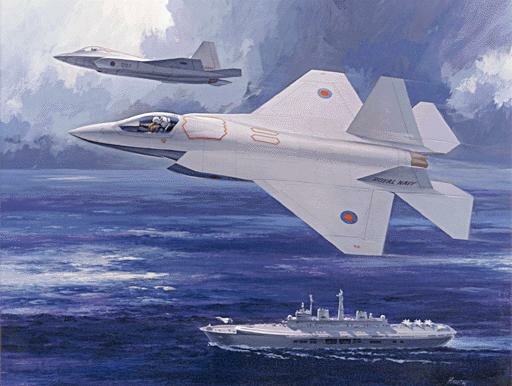
The original Lockheed CALF did have a two-dimensional thrust-vectoring nozzle for the CTOL variant similar to the F-22's, but this was later changed to an axisymmetric one to reduce weight and cost, although I don't recall if this occurred before or after CDP.
Last edited:
Similar threads
-
Lockheed Martin F-16 Fighting Falcon Developments
- Started by seruriermarshal
- Replies: 630
-
-
-
-
RCAF Airbus CC-150 Polaris Replacement Program
- Started by Jason Dykstra (Wyvern)
- Replies: 52

